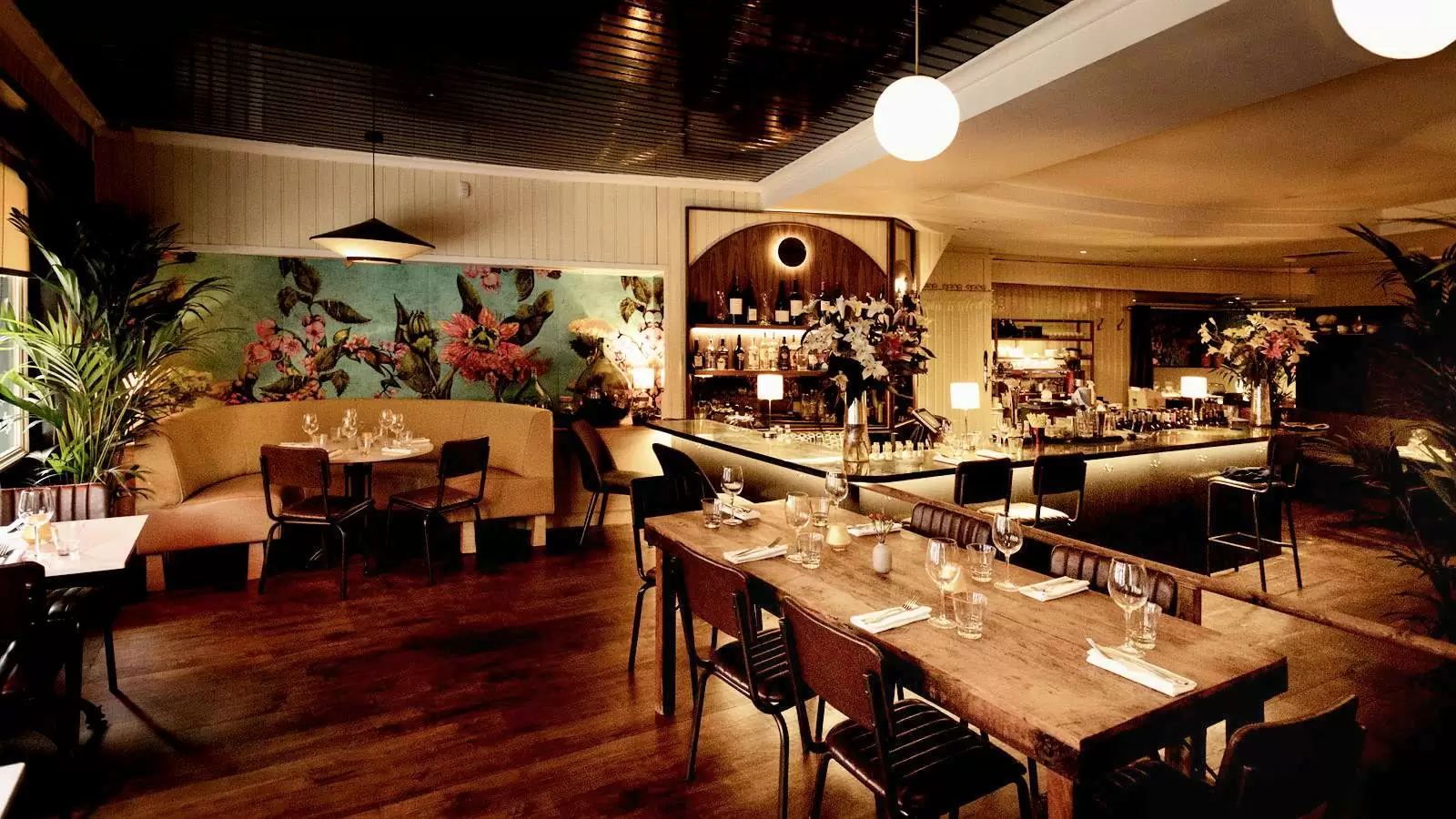Email marketing strategy might not be the first thing you think of when it comes to promoting your restaurant. But when done well, it can be as effective as other digital marketing channels like social media and search engine optimisation (SEO).
A thoughtful email marketing strategy can help grow your restaurant’s customer base, get more guests in the door and boost revenue. Most email marketing tools offer detailed analytics, too, so you’ll have the numbers you need to measure ROI.
Here’s a rundown of email marketing best practices, plus useful success metric calculators to get you started.
Quick Links
What is email marketing?
Why do restaurants need an effective email marketing strategy?
15 best practices for email marketing
What are the most important email marketing metrics
How to calculate your restaurant email marketing ROI
Examples of email marketing for restaurants
What is email marketing?
Unlike social media, email is a direct link between you and your guests. There is no middleman. (We’re looking at you, Mark Zuckerberg.)
This makes email one of the most bankable direct marketing channels.
Email allows restaurants to share everything from new menu items to limited-time deals with potential customers.
To start, you’ll need an email marketing tool to collect emails from people who opt-in to receive communications.
- Mailchimp
- Emma
- HubSpot
- Constant Contact
To get the most out of an email tool, make sure it integrates with other parts of your tech stack. OpenTable integrates with the most popular email tools.
If you’re wondering whose job email marketing is, it varies. A restaurant owner, marketing staffer or communications agency can create an email marketing strategy to drive sales.

Why do restaurants need an effective email marketing strategy?
Email marketing gives you a direct line to diners. On social media, constantly changing algorithms mean that even people who follow your account sometimes won’t see your content because the platform decides not to serve it to them. That makes a restaurant’s email list incredibly valuable.
Social media is the number one place consumers go for info about restaurants, with 58% of respondents to OpenTable Q2 Diner Survey saying it’s their go-to. But email isn’t far behind, according to a Statista survey, 52% if people like receiving marketing emails from restaurants.
Another reason to invest in email marketing strategy is the potential ROI. The Data & Marketing Association found that the ROI for emails was £35.41 for every £1 spent. That’s a stat that will make most stand up and pay attention.
Globally, 4.6 billion people are projected to use email by 2025, according to Mailchimp. You don’t want to miss out on this digital marketing channel.
15 best practices for email marketing
Use these best practices to get the best ROI out of your email marketing strategy—and avoid getting stuck in spam folders.
1. Make it easy for people to sign up
Make signups easy and convenient. Add a pop-up to your website with a signup field for your newsletter. It also helps to add a place to sign up for emails on your homepage, contact page, or website footer.
Add your email signup link to your social media pages to get even more people on your list. You can even create the opportunity to sign up for emails by including a QR code on your menu that links to your restaurant’s email signup page.
2. Never pay for email addresses
It might seem smart to beef up your contacts by buying an email list, but it’s not a good idea. Putting people who didn’t opt into your list will tank your open rate without accomplishing your marketing goals. Some email marketing even tools prohibit the use of bought email lists outright.
Instead, build your email list organically as part of your email marketing strategy. That way, the people who sign up are actually interested in your restaurant. It’ll make your email campaigns much more effective.
A better way to get strong ROI from your email marketing strategy is to link your POS system or restaurant CRM to your email platform. Use customer data to create targeted segments that lead to better results.

3. Enable double opt-in for high-quality contacts
Double opt-in requires subscribers to confirm that they want to be on your email list, usually by clicking a link in an email sent right after signup.
Taking this extra step ensures that only interested people subscribe, which can give you better ROI on email marketing over the long term. However, not everyone will follow through, so subscriber rates can be lower than without double opt-in.
4. Create a content calendar
Think ahead when planning your digital marketing strategy. Give yourself four to eight weeks lead time so you can think through everything coming down the pike at your restaurants.
What holidays, special events or other opportunities for promotion are happening in the next two months? For example, you’ll want to start promoting New Year’s Eve right as soon as November and Mother’s Day brunch specials in January.
It wouldn’t be too far in advance to roughly plan three months’ worth of emails at the start of every quarter.
5. Optimise subject lines and preview text
The contents of your email don’t matter if the recipient doesn’t open it. That’s why subject lines – and the preview text that follows them – are so important.
It’s a good idea to keep email subject lines around 30 to 50 characters. This is the length that most services allow before cutting words off. Use language to create a sense of urgency and offer an incentive for opening that email.
There are many resources online that can help you create effective subject lines. Check out:
- Best Practices for Email Subject Lines from Mailchimp
- How to Write an Excellent Email Subject Line from Business Insider
- 10 Best Practices to Write the Perfect Email Subject Line from Content Marketing Institute
Preview text, the snippet that appears after an email’s subject line in your inbox, is another opportunity to grab attention and entice readers to click. Shoot for short and snappy, as preview text can be cut off after as little as 35 or 40 characters.

6. Use personalised greetings
An email addressed to a person by their name grabs more attention than one with a generic greeting. Most email marketing tools make it easy to automatically display each recipient’s name in the salutation.
7. Keep the most important info up top
Attention spans are short these days. Once a subscriber opens an email, you have a split second to get your message across. That means short and concise headlines, enticing photos and direct language. Avoid being wordy or writing big blocks of text that are tough to read.
8. Use eye-catching photography
One of the first things a reader sees when they open a marketing email is the large image at the top, known in email marketing speak as the hero image. Put your best foot forward with beautiful, well-lit photos that inspire readers to take an action such as clicking on it.
9. Shout out your specials
Put a can’t-miss offer in your email subject line to inspire subscribers to open. Lead with happy hour discounts, weekly specials or seasonal ingredients to get readers to click. Spell out why they need what you’re offering in the body of the email.
10. Segment your audience
Once you’ve got the hang of email marketing best practices, you can take things to the next level. Integrate your email client with your reservation platform or POS and use the data to divide your email list into segments. You can target audiences more accurately this way.
For example, you’ll want to communicate differently with regulars than with guests who only come in a few times a year. By segmenting your email list, you can communicate with guests in a way that’s more likely to get them in the door.

11. Include a call to action (CTA)
Usually, a restaurant sends emails because it wants people to do something. For restaurants, that means making a reservation, placing an online order or coming in for a meal.
Make your call to action clear and easy to see. A big, colourful button is great for this. Use language that inspires guests to click through to your landing page, reservation platform or menu. Some great calls to action include:
- Book a table
- See the menu
- Learn more
- Order now
It doesn’t need to be flashy – it’s about getting to the point and letting guests know the benefits available to them.
12. Add an unsubscribe link
Another email marketing best practice is making it easy for people to opt out. Indeed, it’s mandatory to include an unsubscribe link in Ireland – you need to give them the option to opt in or opt out from marketing emails.
13. Test your emails
How can you tell a good email from a bad one? Test them to find out which is more effective.
Most email marketing tools offer A/B testing. Instead of sending the same campaign to your entire list, A/B testing sends two options to a small portion of your email list. The program uses metrics like opens and click through rates to determine which one goes to the whole list.
Once you’ve tested your emails a few times, you’ll get a sense of the email content your target audience responds to most.
14. Keep your list clean
Even high-quality email content won’t please everyone. You’re bound to have some people who unsubscribe. Others will stay subscribed but not open your emails. It may seem better to keep them on your list, but those contacts aren’t actually interacting with your content.
The result is a low open rate, which can make your campaigns seem ineffective. Instead, periodically remove contacts from your list if they haven’t opened your emails for a while. Many email platforms can automate this for you.
15. Set up a welcome sequence
Automated sequences, or email flows, make it easy to onboard new contacts. A preset series of welcome emails begins as soon as a contact signs up.
Automated sequences don’t replace regular email blasts but work to drive sales as part of a larger email marketing strategy. Everyone who signs up gets the same sequence, allowing you to focus on other marketing tasks.
The first email in an automation should go out right after a potential guest signs up. If you’ve offered an incentive like a discount code or freebie in exchange for subscribing to email marketing, include it here.
Plan a few more emails in the welcome sequence based on your marketing strategy. For example, you can promote your social media channels or highlight happy hour specials.
How to measure the effectiveness of your restaurant marketing emails
Of course, the big question centres around just how you measure the ROI of your restaurant’s marketing emails. But before we get into the nitty-gritty, here are some key terms that will provide more context.
What are the metrics to look for?
- Open rate is the percentage of recipients who open or view a particular email out of the total number of emails sent.
- Click-through rate (CTR) is the number of email recipients who clicked on one or more links contained in a given email, out of the total number of emails opened. You can calculate CTOR by dividing your unique email opens by your unique email clicks and multiplying by 100
- Click-to-open rate (CTOR) is how many email recipients clicked on a link within an email relative to the number of recipients who opened that email. This metric provides insights into the effectiveness of the email content and layout.
- Unsubscribe rate is the percentage of recipients who choose to opt out of receiving future emails from a sender, relative to the total number of emails sent. This metric provides insights into recipient satisfaction and engagement with the email content.
How to calculate these metrics
Define your goals
Before knowing what to calculate regarding metrics, you need to define your goals. Are you trying to increase foot traffic, promote a new menu item or boost online orders? Your goals will dictate what metrics you need to track.
Track your costs
This includes not just the direct cost of sending the emails (like an email marketing service subscription), but also the time you or your staff spend designing, writing and managing your email campaigns.
Set up email tracking
Most email marketing platforms allow you to track key metrics such as open rate, click-through rate and bounce rate. You can also set up tracking codes to see what actions people take on your website after clicking a link in your email. We’ve even partnered with email platforms like Personica, Emma, Yext and Mailchimp to enrich your marketing.
Track sales from email campaigns
Tracking sales can be more challenging, but it’s crucial for calculating ROI. You can use promotional codes that are exclusive to your email subscribers, or if your email marketing platform and point-of-sale system can integrate, you might be able to track this directly.
How to calculate the ROI on your restaurant marketing emails
Now that you have your costs (investment) and your additional sales (return), you can calculate ROI with the following formula:
ROI = [(Net Profit – Investment) / Investment] ÷ 100
Here’s an example: if you spent €500 on your email marketing campaign, and you made an additional €1,500 in sales from that campaign, your ROI would be 200%. That means you earned twice what you spent.
Adjust and improve
Use the data you’ve gathered to find ways to improve your email marketing. For example, if you notice that your open rate is low, you might need to rethink your subject lines. Or if your click-through rate is low, you could try changing the call to action or the design of your email to see if it leads to better results.
Remember, though, that not all benefits of email marketing are sales-related – at least not at first. For instance, a customer might decide to visit your restaurant after seeing several of your emails, even if they didn’t click a link in the email. There’s always an opportunity to build the brand.
Likewise, they might recommend your restaurant to a friend after getting your emails. So while ROI is a useful metric, it doesn’t paint the entire picture of your marketing efforts.
What are the industry benchmarks for each metric
So what metrics should you aim for with your email marketing? According to research, the industry standard benchmarks for the hospitality industry are as follows:
- Open rate: 40.88%
- Click rate: 1.66%
- Click-through rate (CTR): 4.05%
- Unsubscribe rate: 0.48%
- Bounce rate: 0.38%
Use these stats as a guideline, but if you’re just starting out, it may take some patience before you achieve 40% open rates and the like. By keeping consistent and learning as you go, your restaurant can craft a high-converting email marketing strategy that gets more diners through the door.
Examples of email marketing for restaurants
Once you’ve thought about your email marketing strategy, signed up for an email marketing tool, and built an email list, it’s time to send some campaigns.
Use these examples of restaurant emails to inspire your strategy.
Create urgency
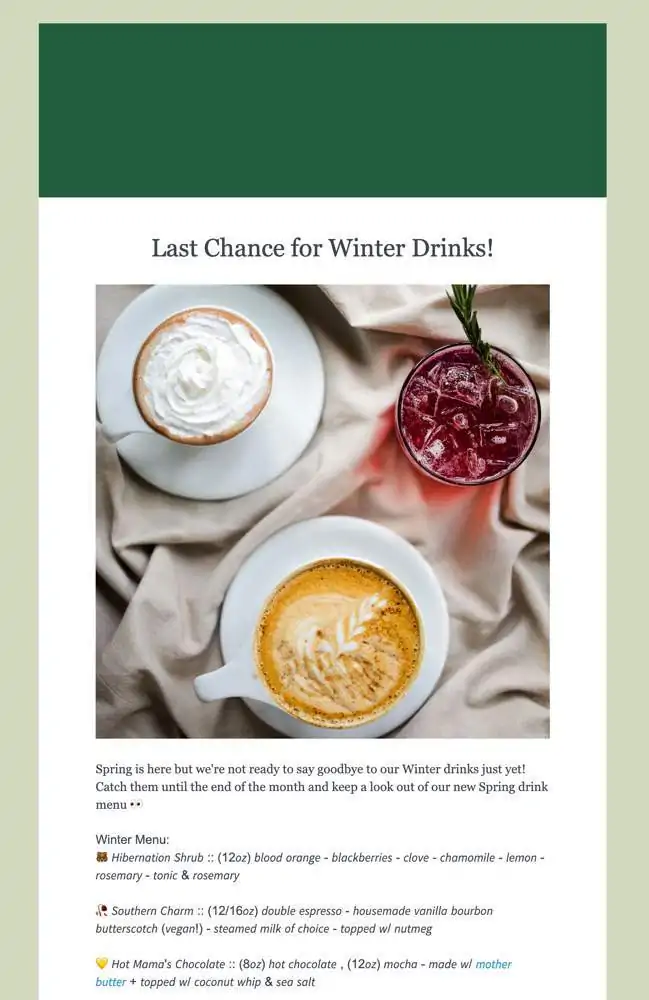
This marketing email from mission-driven cafe Rally creates a sense of urgency with the headline and a few brief sentences. A big, beautiful photo tempts customers. A list of drink specials bulleted with emojis gives them the info they need to act.
Offer a deal
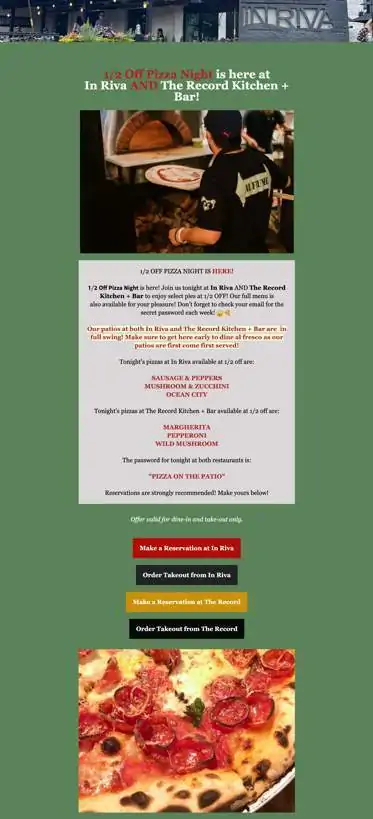
Neapolitan-style pizzeria In Riva puts a can’t-miss deal front and center. The copy uses bold text, all-caps, and emojis to create a sense of fun and excitement while keeping things readable. Reservation and order buttons are bold, colorful, and easy to find.
Send an update
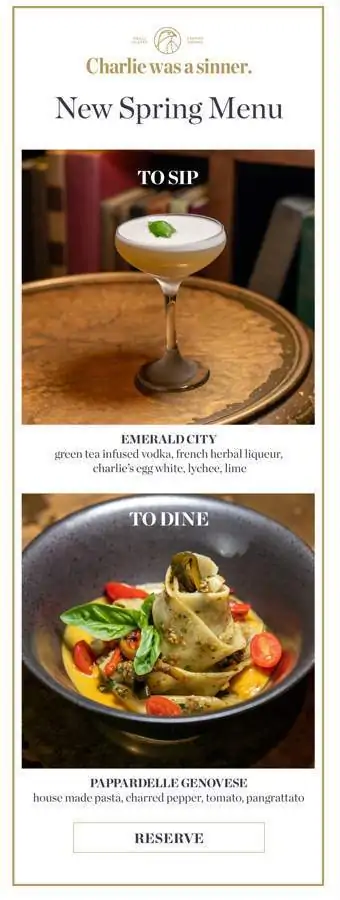
Plant-based restaurant and bar Charlie Was a Sinner uses a short, direct headline to get their message across. Close-up, high-quality photos grab the recipient’s attention. A prominent call-to-action button prompts them to make a reservation.
Promote a special event
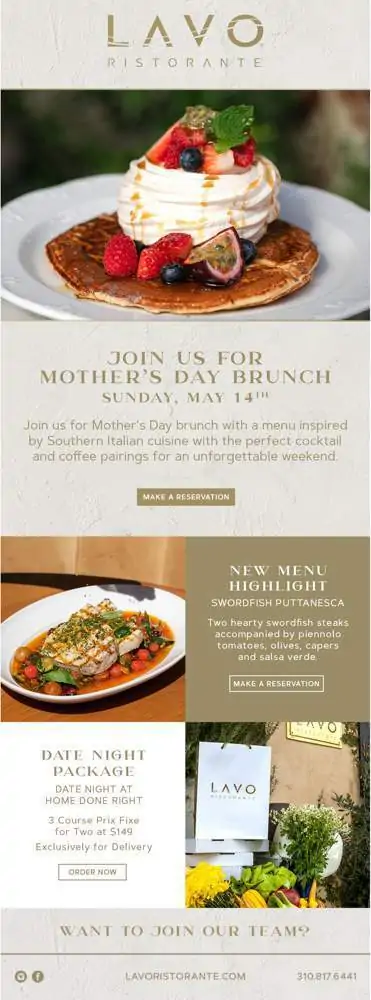
Lavo Ristorante uses a clean, photo-rich email template that’s easy for staff to organize and for guests to read. This marketing email highlights a big upcoming holiday up top while shouting out other promotions in smaller blocks below.
Build your brand
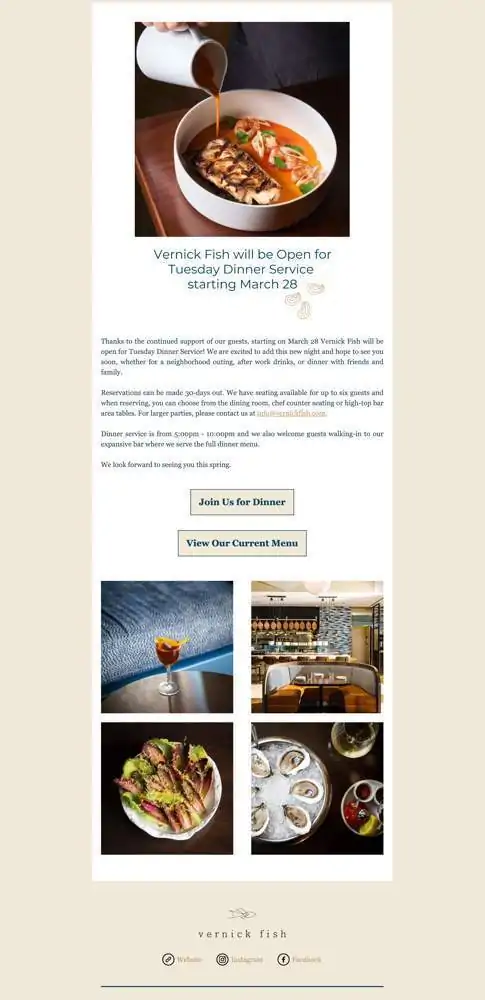
Seafood restaurant Vernick Fish uses short paragraphs and a direct, elegant tone to convey the business’s brand voice. Bold, outlined buttons direct readers, while beautiful photos remind patrons why they love dining there.
Use these email marketing examples for restaurants to get ideas and inspiration for how to use this important digital marketing channel in your business. With a little planning and time, you can strengthen the connection between your restaurant and your guests, raise your profile, and grow revenues with your email marketing strategy.
Excellent email marketing
Harnessing the power of email marketing requires a blend of creativity, strategic thinking and an understanding of your audience. Using the 15 strategies we’ve covered, you can execute a well-crafted email marketing campaign that significantly boosts your restaurant’s visibility, engagement, and ultimately, sales.


